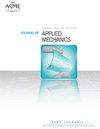可编程机械响应的周期界面剪切波引起的摩擦力
IF 2.8
4区 工程技术
Q2 MECHANICS
引用次数: 0
摘要
非线性声子材料通过将非线性与其固有的周期性相结合,实现了优越的波响应,为开发新型声学设备创造了机会。然而,该领域主要关注可逆非线性,而滞后非线性的作用仍未得到探索。在这项工作中,我们研究了由摩擦粗糙接触的滞后非线性引起的非线性剪切波响应,并利用这些响应实现可编程功能。使用数值方法,我们解决了剪切波通过单个接触和周期性接触阵列传播的强非线性问题,考虑了摩擦效应。具体而言,使用具有实验获得特性的Jenkin摩擦模型来捕捉接触处的粘滑过渡效应。结果表明,摩擦会产生剪切极化本征应变,这是系统内的残余静态变形。然后,我们展示了多个触点中的本征应变生成如何实现可编程功能,如声学控制的机械开关、精确位置控制和表面可重新配置。总的来说,我们的发现为利用摩擦接触的滞后非线性通过声波设计具有先进功能的智能材料和设备开辟了新的途径。本文章由计算机程序翻译,如有差异,请以英文原文为准。
Shear Wave-induced Friction at Periodic Interfaces for Programmable Mechanical Responses
Nonlinear phononic materials enable superior wave responses by combining nonlinearity with their inherent periodicity, creating opportunities for the development of novel acoustic devices. However, the field has largely focused on reversible nonlinearities, whereas the role of hysteretic nonlinearity remains unexplored. In this work, we investigate nonlinear shear wave responses arising from the hysteretic nonlinearity of frictional rough contacts, and harness these responses to enable programmable functions. Using a numerical approach, we solve the strongly nonlinear problem of shear wave propagation through a single contact and a periodic array of contacts, accounting for frictional effects. Specifically, the Jenkin friction model with experimentally-obtained properties is used to capture the effects of stick-slip transition at the contacts. Results show that friction gives rise to shear-polarized eigenstrains, which are residual static deformations within the system. We then demonstrate how eigenstrain generation in multiple contacts can enable programmable functionalities such as an acoustically-controlled mechanical switch, precision position control, and surface reconfigurability. Overall, our findings open new avenues for designing smart materials and devices with advanced functionalities via acoustic waves using the hysteretic nonlinearity of frictional contacts.
求助全文
通过发布文献求助,成功后即可免费获取论文全文。
去求助
来源期刊
CiteScore
4.80
自引率
3.80%
发文量
95
审稿时长
5.8 months
期刊介绍:
All areas of theoretical and applied mechanics including, but not limited to: Aerodynamics; Aeroelasticity; Biomechanics; Boundary layers; Composite materials; Computational mechanics; Constitutive modeling of materials; Dynamics; Elasticity; Experimental mechanics; Flow and fracture; Heat transport in fluid flows; Hydraulics; Impact; Internal flow; Mechanical properties of materials; Mechanics of shocks; Micromechanics; Nanomechanics; Plasticity; Stress analysis; Structures; Thermodynamics of materials and in flowing fluids; Thermo-mechanics; Turbulence; Vibration; Wave propagation

 求助内容:
求助内容: 应助结果提醒方式:
应助结果提醒方式:


